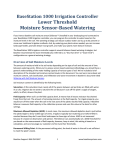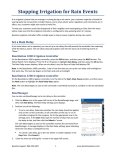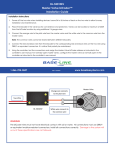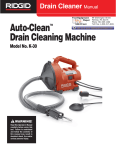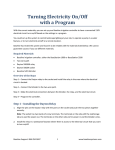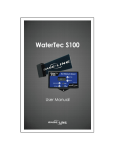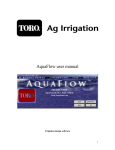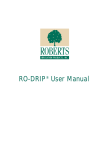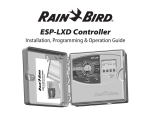Download BaseStation 3200 Quick Reference – 11.7.5.15
Transcript
BaseStation 3200 Advanced Irrigation Controller Quick Reference Guide March 19, 2012 Customer Service 1-866-294-5847 Baseline Inc. www.baselinesystems.com Phone 208-323-1634 FAX 208-323-1834 Toll Free 866-294-5847 ©2012 Baseline Inc. All Rights Reserved. Revision 2 Table of Contents BASESTATION 3200 DIAL POSITIONS ............................................................................................................ 1 AUTO RUN ..................................................................................................................................................... 1 Program Status.......................................................................................................................................... 2 Moisture biSensor Data ............................................................................................................................ 2 Water Used ............................................................................................................................................... 2 Pause Conditions....................................................................................................................................... 3 Operator Messages ................................................................................................................................... 4 Zone Water Times ......................................................................................................................................... 5 Start Times .................................................................................................................................................... 6 Program Start Times ................................................................................................................................. 6 Program Water Windows ......................................................................................................................... 6 Day Intervals ................................................................................................................................................. 6 Seven Day Schedule .................................................................................................................................. 7 Historical ET Calendar ............................................................................................................................... 7 Even Days .................................................................................................................................................. 7 Odd Days ................................................................................................................................................... 7 Odd Days and Skip 31st.............................................................................................................................. 7 Soak Cycle ..................................................................................................................................................... 7 MV/Pump Start ............................................................................................................................................. 7 Date/Time ..................................................................................................................................................... 8 Event Days..................................................................................................................................................... 8 Flow Menu .................................................................................................................................................... 8 biSensor Menu .............................................................................................................................................. 9 biCoder Menu ............................................................................................................................................... 9 AUX.............................................................................................................................................................. 10 AUX – Rain/Off ........................................................................................................................................ 10 AUX – Temp/Pause ................................................................................................................................. 10 AUX – Passcodes ..................................................................................................................................... 11 AUX – USB Data....................................................................................................................................... 11 Page i AUX – Clear All ........................................................................................................................................ 12 AUX – Valves ........................................................................................................................................... 12 AUX – Budget .......................................................................................................................................... 12 AUX – System .......................................................................................................................................... 12 Self-Test ...................................................................................................................................................... 13 Self-Test – Test Zone ............................................................................................................................... 13 Self-Test – Test biSensor ......................................................................................................................... 13 Self-Test – Test All ................................................................................................................................... 13 Self-Test – Verify and Repair ALL ............................................................................................................ 14 Manual Run Program .................................................................................................................................. 14 Manual Water ............................................................................................................................................. 15 OFF .............................................................................................................................................................. 15 Page ii BaseStation 3200 Quick Reference Guide BASESTATION 3200 DIAL POSITIONS The BaseStation 3200 Quick Reference Guide describes the functions that are available when you select the various dial positions on the controller. You will find the instructions for using these functions to configure the controller in the BaseStation 3200 Advanced Irrigation Controller User Manual. The topics in this Quick Reference Guide refer to the related instructions in the User Manual. AUTO RUN The main screen displays when the dial is in the Auto Run position. This screen shows status for all elements of the 3200 controller. Air Temp – Shows “None” if no air temperature sensor is connected to the system, otherwise shows the current air temperature. Remote – Indicates the status of remote communications to the 3200. Possible indicators include: • None – No remote communication devices were detected. • Idle – One or more remote communication devices were detected, but none are in use at this time. • BL Commander – A BL Commander remote control is currently active. • Active – BaseManager central control software is currently connected to and communicating with the controller. Two-wire – Indicates the approximate current being supplied to the twowire path. The value will vary with the size of the installation and the number of active valves. When the system is not watering, the two-wire status is OFF. Flow – If there is no flow meter installed, the controller shows the estimated flow (in brackets) based on the flow values that have been set for each zone. With one or more flow meters, the controller indicates the total flow measured. This value is updated once each minute, and is shown without brackets. More detail is available in the flow reports. Prog – Shows the status of all programs. Refer to the status color key on the label inside the door of the controller. MV – Shows the status of each master valve. Zone Status – The lower section shows the current status of the zones in groups of 50 zones. Press the +/– keys to move between the groups 50 zones. Page 1 BaseStation 3200 Quick Reference Guide You can access the additional status screens that are available with the dial in this position by pressing the NEXT/PREV buttons. Program Status Each program has a status report. The top line indicates the program, the assigned mainline, and the program run time from the previous day (this is the total of all program zone run times). While a program is active, there is a progress bar providing an indicator of the time left for the program. The other lines indicate run times, and the completion date/time of the previous program run. The estimated water used is the sum of the zone run times multiplied by their estimated water flow rates. Press the +/– buttons to move between the reports for the various programs. Moisture biSensor Data The Soil Moisture Sensor Data report shows a moisture graph for each of the moisture sensors connected to the controller. The graph shows the watering limits: • Green line = lower limit – Allow watering at the next start time when the moisture has dropped below this limit • Red line = upper limit – Stop watering during a water cycle when the moisture reaches this limit Press the +/– buttons to change the biSensor that is being displayed. The sensor number displays below the graph. To change the moisture range displayed on the graph, press the ENTR button. The range changes by 5% each time you press the button. Water Used The BaseStation 3200 provides two types of water used reports. • Report for controllers that do not have a flow sensor In this report, all flow and water used values are estimated from the flow values for each of the zones. The flow is the sum of the individual flow values for each of the zones that are currently watering. The water used is the sum of the flow rate of each zone times the water time (for example, 15 GPM x 30 MIN = 450 GAL). • Report for controllers that have one or more flow sensors This report indicates the actual flow measured, and the actual water used that has been accumulated by the flow biCoder. These values are determined by the combination of the flow sensor, its configuration, and its accuracy. Press the +/– buttons to scroll through each of the flow reports. Page 2 BaseStation 3200 Quick Reference Guide Pause Conditions A variety of conditions will cause the controller to pause watering, either by specific programs or the entire controller. When one or more pause conditions occur, the Pause Condition reports describe the reasons for the pause conditions. Press the +/– buttons to scroll through the list of active pause conditions. The following pause conditions can occur on the BaseStation 3200. BLCommander (handheld radio) • All programs will be paused while running a zone using the remote handheld radio – all programs resume when the zone is shut off. • Press the CLR button to terminate the manual zone. • Automatically cleared when the zone is done. BaseManager (central control software) • Normal operation continues while the controller is accessed by BaseManager. • Press the CLR button to terminate the BaseManager connection. • Automatically cleared when BaseManager logs off. Event Day • An event day stops all watering and keeps programs from starting. • Press the CLR button to terminate the event day. • Automatically cleared when the event day ends. • A high-flow shutdown or an over-budget shutdown stops the system from using the specific flow device. • Press the CLR button to reset a high flow shutdown condition. • Pressing the CLR button does not clear an over-budget condition. Change the budget or wait until next month. • Not automatically cleared – the user must clear this pause condition. • An open jumper or flow switch stops all watering and keeps all programs from starting. • Pressing the CLR button does not reset this condition. Replace the jumper or reset the flow switch hardware. • Not automatically cleared – the user must clear this pause condition. • When the temperature drops below 38 F, the system will pause all watering. • Pressing the CLR button does not reset this condition. You must wait until the temperature rises. • Automatically cleared with higher temperatures. • A pause biCoder will pause watering on specific programs. • Pressing the CLR button resets the pause condition before the delay time has elapsed. • Automatically cleared at end of the delay time. Flow Devices Flow Switch Low Temperature Pause biCoder ◦ Page 3 BaseStation 3200 Quick Reference Guide Pause Switch Rain Switch Rain/OFF days Water Window • An open jumper or wired switch pauses all watering on the controller. • Pressing the CLR button does not reset the pause condition until the jumper or switch has closed the circuit. Then pressing the CLR button resets the pause condition before the delay time has elapsed. • Automatically cleared at end of the delay time. • An open jumper or wired rain sensor that is wet (open) stops all watering and keeps all programs from starting. • Pressing the CLR button does not reset the pause condition until the jumper or rain sensor has closed (dried out). • Automatically cleared when the switch or rain sensor closes. • Setting a rain/off value for the number of days stops all watering for that period of time. • Pressing the CLR button resets the delay days to zero and clears the pause condition. • Automatically cleared when delay days are over. • A water window (white squares) will pause a program. • Pressing the CLR button does not reset the water window pause condition – you must wait or change the water window programming. • Automatically cleared when the water window expires (time advances to a blue square). Operator Messages Operator Messages are used to indicate programming errors and to provide assistance in fixing common installation and operation problems. Messages can include status or warning messages, or serious controller alarms. The message shows the time and date of the alert. The message also includes suggestions for correcting the issue. Operator Messages are prioritized so the most serious messages is shown first in the Messages report screen. After you have read the message and taken the appropriate action, press the CLR button to clear the message. If there are multiple messages, press the +/– buttons to scroll through the messages. The most common messages are listed below: • biSensor Disabled – error rate too high • Insufficient time between program starts • Water used exceeded monthly budget • Rain/Off Delay has stopped watering • Calibrate Failure – no moisture change • Rain Switch has stopped watering • Calibrate Failure – saturation not reached • The valve is a short-circuit • Water flow rate has exceeded limit • The Start Time was Skipped • Learn Flow Zone Successful • Two-wire Current is too High • Watering Stopped by Low Temperature • Unscheduled Flow exceeded limit Page 4 BaseStation 3200 Quick Reference Guide • The valve is an open-circuit • Water Window has stopped watering • The valve current is too high • Zone flow exceeds design flow • Pause biCoder has paused watering • High Flow has terminated zone watering • Pause Switch has paused watering • Low Flow has terminated zone watering Zone Water Times When you assign a biCoder to a zone number, default settings are given to the zone. You can view and modify these values by turning the dial to the Zone Water Times position. You can configure the following settings for each zone: Zone – When this field is highlighted, press the +/– buttons to select a different zone number. biCoder – Set this field to Enabled when you want to use a zone for normal operation. Change the field to Disabled to keep it from running during maintenance or other conditions. Zone Mode – There are three modes for zones in the BaseStation 3200. Timed • The default for newly assigned zones. In this mode, you can program the zone to water in a time-based manner (like other irrigation controllers). Primary • This zone type is used for the first zone in a zone scheduling group. Making changes to a primary zone will automatically make corresponding changes in all linked zones. • A biSensor can only be assigned to a primary zone. • A linked zone waters according to the programming of the primary zone that it is linked to. If zone 2 is linked to primary zone 1, then it will use the same programming as zone 1. • A linked zone must have a higher number than the primary zone that it is linked to. Linked Water Time – You can set the zone water time from 1 minute to 23 hours 30 minutes. Linked zones are programmed as a tracking ratio or percentage of the primary zone. For a primary zone set to 60 minutes, a linked zone that is programmed at 150% would have a water time of 90 minutes. Linked zone ratios range from 30% to 1000%. Changing the primary zone to a new water time will adjust linked zones by their tracking ratios. Program – You can create up to twenty programs (A to T) for ultimate flexibility. A zone may be assigned to any program. Linked zones are automatically assigned to the program of their primary zone and cannot be changed independently. For More Information Read Setting Up Time-Based Watering in the BaseStation 3200 User Manual. Page 5 BaseStation 3200 Quick Reference Guide Start Times Under the Start Times dial position, you can access the settings for start times and water windows. Program Start Times Each active program must have at least one start time. If a program has no start time, it is disabled and will not run. Programs can have from one to eight start times. Start times are set in 15 minute increments. For More Information Read To set up the start times for a program in the BaseStation 3200 User Manual. Program Water Windows Water windows tell the controller when watering is allowed and not allowed. You can set water windows for either Weekly (shown on the screen shot) or Daily. If you use “Weekly” to set up the water windows and then you decide to convert to “Daily,” the weekly settings are copied to each day of the week. Selecting daily water windows gives you hourly control of watering for each day of the week and for each program. A white square does not allow watering for that hour. For More Information Read To set up the water windows for a program in the BaseStation 3200 User Manual. Day Intervals The Day Intervals dial position is used to specify the calendar days that will allow watering for each program. A program that is started on one day will continue to run until it completes, even if it needs to continue to the next day, which may or may not be a watering day. For example, if a six-hour program starts at 10 PM on Monday, it will finish at 4 AM on Tuesday, even if Tuesday is not a watering day. For More Information Read Setting Up Programs in the BaseStation 3200 User Manual. Several day interval modes are available. Each mode provides a different calendar scheduling methodology. Page 6 BaseStation 3200 Quick Reference Guide Seven Day Schedule By default, new programs use a seven day schedule to determine possible watering days. The individual days of the week can be set to either Y (yes) or – (no). When a day is set to Y, a start time will start the program. Historical ET Calendar The Historical ET Calendar mode enables you to set up a watering schedule for the entire year that compensates for seasonal changes without your having to adjust times and frequency multiple times throughout the year. For More Information Read To set up historical ET-based watering for a program in the BaseStation 3200 User Manual. Even Days This day interval mode allows programs to start on even days of the month. Odd Days This day interval mode allows programs to start on odd days of the month. Odd Days and Skip 31st st This day interval mode allows programs to start on odd days of the month, and does not allow watering on the 31 of the month. In this way, the system will maintain a schedule of every two days even when crossing into a new month. Soak Cycle Soak cycling breaks the total run time into shorter water “cycles” with “soak” periods in between to allow time for water to soak into the soil. Properly setting soak and cycle times will dramatically improve water penetration and watering efficiency. For More Information Read Understanding Soak Cycling and Using Soak Cycles in the BaseStation 3200 User Manual. MV/Pump Start Use the MV/Pump Start dial position to associate master valves to specific programs. For a Normally Closed Master Valve, you assign the valve decoder to it in the biCoder Menu dial position, and then associate it with a program in this screen. Normally Open Master Valves are based on the flow device number. For More Information Read Multiple Flow Devices and Mainlines in the BaseStation 3200 User Manual. Page 7 BaseStation 3200 Quick Reference Guide Date/Time Set the date and time when the controller is installed and when it is powered back up after being shut down for an extended period of time. The real-time clock circuit is maintained for several days during a power outage, but it will lose track of time after a week or more. For More Information Read Setting the Controller Date and Time in the BaseStation 3200 User Manual. Event Days The BaseStation 3200 supports eight event days. An event day stops all watering and keeps all programs from starting on that date. You can schedule an event day up to a year in advance. For More Information Read Setting Up Event Days in the BaseStation 3200 User Manual. Flow Menu The Flow Menu dial position provides the programming for flow management and control. The BaseStation 3200 provides an extensive set of flow monitoring and management capabilities to help understand how water is being used and to reduce the effects of pipeline breaks and sprinkler malfunctions. It can monitor actual water flow rates and compare them against the expected or design flow rates and provide alerts and perform actions when limits or boundaries are exceeded. The system can reduce the overall completion time of a watering cycle by running the number of zones that best use the available water at each minute of the watering cycle. For More Information Read Flow Management & Monitoring in the BaseStation 3200 User Manual. Page 8 BaseStation 3200 Quick Reference Guide biSensor Menu The biSensor Menu dial position enables you to search for and configure the soil moisture sensors (biSensors) that are connected to your BaseStation 3200. For More Information Read the following topics in the BaseStation 3200 User Manual: Searching for biSensors Assigning Soil Moisture Sensors (biSensors) to Primary Zones To configure your biSensors and set up watering strategies biCoder Menu The first step in programming the BaseStation 3200 controller is assigning valve biCoders to zone numbers. In order to activate a valve, the valve biCoder that is attached to the valve solenoid must be assigned a zone number. Then you can activate the valve by turning on the zone, either manually or with a program start. For More Information Read Searching for biCoders in the BaseStation 3200 User Manual. After you have connected the first valve biCoders to the two-wire, do a Search operation to find each of the twowire devices and then assign them to their corresponding zone numbers. For More Information Read Assigning biCoders to Zones in the BaseStation 3200 User Manual. Status codes identify the status of the biCoders that have been configured into the system. OK – Working properly OP – Open circuit SC – Short circuit ER – Communication error Page 9 BaseStation 3200 Quick Reference Guide You assign master valves and pump start biCoders in this same dial position. Select MV1 to MV4 for the zone number during the assignment process. Note: If you have a Flow + NOMV device, assign it first in the Flow Menu dial position, and then use the remaining free MV locations for other master valves or pump start biCoders. For More Information Read the following topics in the BaseStation 3200 User Manual: Configuring a Master Valve/Pump Start biCoder Associating a Master Valve/Pump Start biCoder with Programs Configuring a Flow Device AUX The AUX dial position gives you access to the following functions. AUX – Rain/Off This function will stop all water for a specified number of days. Setting the days to one will stop watering for the rest of the day and resume normal watering at midnight. You can set the number of delay days between 1 and 365. When a Rain/Off stop watering is active, you can clear it by changing the number of days to zero on the Rain/Off screen. For More Information Read Setting Up a Rain Delay in the BaseStation 3200 User Manual. AUX – Temp/Pause This menu will display the presence of an air temperature sensor if one is connected to the two-wire. This screen has a search function to find twowire devices. For More Information Read Searching for Pause biCoders and Temperature Sensors and Configuring Pause Devices in the BaseStation 3200 User Manual. Page 10 BaseStation 3200 Quick Reference Guide AUX – Passcodes The BaseStation 3200 has two levels of access for BaseManager central control access: read-only and read-write access. You can configure passcodes for these access levels in the Passcodes screen in the AUX dial position. It is important that the codes be changed from their default values to allow access to those authorized and to restrict further those able to make programming changes. You do not need to set up passcodes if the controller will not be accessed from the BaseManager central control software. For More Information Read Setting Up a Passcode in the BaseStation 3200 User Manual. AUX – USB Data The BaseStation 3200 has a USB port that is used for data and program information. • Backup – After you have created a stable program on your controller, you should create a backup of your program data. Likewise, if you make any programming changes, be sure to create a new backup to capture those changes. You should also create a backup before you do an upgrade to the controller. The backup will allow you to restore to the previous programming if anything goes wrong. • Restore – If your controller has lost its programming data, you can restore it from a backup that you previously made. • Export – The BaseStation 3200 saves up to two years of log files. The controller records all programming changes, run times, moisture levels, and other internal information in these files. The daily files are saved in folders by month. When you perform an export, all of the files are copied to the USB drive in the controller serial number folder, and in a subfolder called Export. • Import – If you upgrade to a new controller, you can import the log files from your old controller so your new controller has access to your historical data. For More Information Read the following topics in the BaseStation 3200 User Manual: Using the USB Data Functions Backing Up Your System Restoring Your System Exporting Log Files Importing Log Files Updating the Controller Software Page 11 BaseStation 3200 Quick Reference Guide AUX – Clear All This function will clear or erase all programming information in the controller. We recommend that you use this function only when directed by Baseline Support. IMPORTANT NOTE! Never clear your programming data without having a current backup available for a restore. For More Information Read Using the Clear All Option in the BaseStation 3200 User Manual. AUX – Valves This function should only be used as directed by Baseline Support. This function provides a way to change the drive characteristics of the valve biCoders to widen support to some non-standard solenoids. Call Baseline Support at 866-294-5847before attempting to use this function. For More Information Read Adjusting the Valve Power Level for a biCoder in the BaseStation 3200 User Manual. AUX – Budget In order to provide a full range of functionality, the BaseStation 3200 controller software includes an option to increase or decrease the amount of time all zones in a program will water. However, we recommend that you use other methods for adjusting the amount of water that your irrigation system is putting down. A healthier way to water turf is to always water deep (about the same amount of time) and change the frequency of watering to maintain the correct moisture level. Use the Day Intervals schedule for better results. For More Information Read To adjust the water budget for programs in the BaseStation 3200 User Manual. AUX – System The System option under the AUX dial position allows you to change the serial number of your controller. It also provides a set of system functions that you should only perform under direction from Baseline Support. WARNING! Only change the serial number of your controller when directed to do so by Baseline Support. If you change the serial number, you will disable your ability to restore your system from a previous backup. Also be aware that it is easy to inadvertently change the serial number when you are in this screen. We recommend that you avoid accessing this screen unless you are directed to do so by Baseline Support. For More Information Read Changing the Serial Number of Your Controller in the BaseStation 3200 User Manual. Page 12 BaseStation 3200 Quick Reference Guide Self-Test The Self-Test dial position provides a set of diagnostic and self-test operations that can verify correct operation and help diagnose problems when they arise. Self-Test – Test Zone When you test a zone, the controller verifies the communication between the controller and the valve biCoder. The controller activates the solenoid and measures the current and voltage. It deactivates the solenoid, and measures the voltage drop between the controller and the valve biCoder. When the test is complete, the results are displayed on the screen. In this example, the solenoid is drawing about 0.18 amps and the two-wire voltage loss is 1.4 volts. If this voltage loss increases over time, then the wire and connections are becoming more resistive and should be checked. When the voltage loss get above 5 volts then communication problems can occur and steps need to be taken to find and repair poor connections and degrading wire. For More Information Read Testing Zones, Valves, and biCoders in the BaseStation 3200 User Manual. Self-Test – Test biSensor When you test a soil moisture sensor (biSensor), the controller verifies the communication between the controller and the biSensor and returns the following readings: • The current soil moisture percentage value • The raw reading from the biSensor (in parenthesis) • The soil temperature from the sensor in degrees Fahrenheit • The two-wire voltage loss (a measure of the wire length and quality between the controller and the biSensor) Note: Voltage drops greater than 5 volts should be repaired. For More Information Read Testing Soil Moisture Sensors (biSensors) in the BaseStation 3200 User Manual. Self-Test – Test All This test checks all the devices on the two-wire and displays a summary screen of the results. If the test finds errors with the devices, the error count is listed for each device type. The quantity of each device type is also given in parenthesis. This test verifies communication and valve currents, biSensor readings, and other device readings, but it does not make any repairs. For More Information Read Testing All Devices in the BaseStation 3200 User Manual. Page 13 BaseStation 3200 Quick Reference Guide Self-Test – Verify and Repair ALL This process searches for and verifies communication with each of the devices on the two-wire. Note: Baseline recommends that you back up your controller data before you run this process. Refer to Backing Up Your System in the BaseStation 3200 User Manual. The Verify and Repair ALL process does not check the valve current or biSensor readings, and it does not repair any faulty wiring or electrical connections. However, if it finds discrepancies in assignments or addressing between the controller and the devices, it will attempt to repair those discrepancies in the following order: • Repair valve biCoder to zone number assignments • Repair biSensor addressing • Repair pause device addressing • Repair air temperature sensor addressing Manual Run Program The Manual Run Program dial position enables you to force a program to start, stop a program that is actively watering, or set the next start date for a program when you are using the Historical ET Calendar interval setting. • A program that is stopped can be started (set to running). It will then run a full cycle when the dial is turned to Auto/Run. • A program that is running can be terminated (set to stopped). • A program that is using a Historical ET Calendar can have its next run date set. Note: Programs that do not use the Historical ET Calendar mode have a fixed schedule and are modified in the Day Intervals dial position. For More Information Read the following topics in the BaseStation 3200 User Manual: Forcing a Program to Start Stopping an Active Program Setting the Next Start Date for a Program Page 14 BaseStation 3200 Quick Reference Guide Manual Water The Manual Water dial position provides a way to run a single zone, all zones or the zones of a program for a specific amount of time. These options enable you to do a system test or a walk-around. For More Information Read the following topics in the BaseStation 3200 User Manual: Manually Running One Zone Manually Running All Zones Manually Running the Zones of a Program OFF Turn the dial to the OFF position when you want to halt all watering for an indefinite period of time. All current watering cycles will be stopped. No watering cycles will be started. Use this dial position for seasonal shutdown. DO NOT power down the BaseStation. When set to OFF, the controller enforces the following conditions: • It will continue to take biSensor moisture readings every ten minutes and log them into flash memory. • It will power down the two-wire (even if it has been set to always be powered up). • It will monitor and record flow rate and water usage and will shut down master valves on high flow, unscheduled flow, or budget exceeded if they are enabled. Flow readings will be taken at the same time as moisture readings Note: The best high flow shutdown is provided with a Flow+NOMV device that is powered externally from a separate 24 VAC power supply. This device can monitor flow rate 24x7, even with the controller in OFF (or powered down) and can shut down the NOMV if the high flow limit is exceeded. Page 15






















